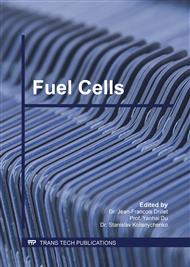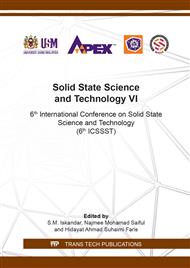[1]
J. Lyagaeva, B. Antonov, L. Dunyushkina, V. Kuimov, D. Medvedev, A. Demin, P. Tsiakaras, Acceptor doping effects on microstructure, thermal and electrical properties of proton-conducting BaCe0.5Zr0.3Ln0.2O3-δ (Ln = Yb, Gd, Sm, Nd, La or Y) ceramics for solid oxide fuel cell applications, Electrochimica Acta 192 (2016) 80–88.
DOI: 10.1016/j.electacta.2016.01.144
Google Scholar
[2]
X.-Z. Fu, J.-Li. Luo, A.R. Sanger, N. Luo, K.T. Chuang, Y-doped BaCeO3-δ nanopowders as proton-conducting electrolyte materials for ethane fuel cells to co-generate ethylene and electricity, J. Power Sources 195 (2010) 2659–2663.
DOI: 10.1016/j.jpowsour.2009.10.069
Google Scholar
[3]
Z. Shao, W. Zhou, Z. Zhu, Advanced synthesis of materials for intermediate-temperature solid oxide fuel cells, Prog. Mater. Sci. 57 (2012) 804–874.
DOI: 10.1016/j.pmatsci.2011.08.002
Google Scholar
[4]
Y. Tao, J. Shao, J. Wang, W.G. Wang, Synthesis and properties of La0.6Sr0.4CoO3−δ nanopowder, J. Power Sources 185 (2008) 609–614.
DOI: 10.1016/j.jpowsour.2008.09.021
Google Scholar
[5]
M. Motta, C.V. Deimling, M.J. Saeki, P.N. Lisboa-Filho, Chelating agent effects in the synthesis of mesoscopicsize superconducting particles, J. Sol-Gel Sci. Technol. 46 (2008) 201–207.
DOI: 10.1007/s10971-007-1673-0
Google Scholar
[6]
Y. Li, J. Zhao, B. Wang, Low temperature preparation of nanocrystalline Sr0.5Ba0.5Nb2O6 powders using an aqueous organic gel route, Mater. Res. Bull. 39 (2004) 365–374.
DOI: 10.1016/j.materresbull.2003.11.002
Google Scholar
[7]
I. Singh, R.K. Bedi, Surfactant-assisted synthesis, characterizations, and room temperature ammonia sensing mechanism of nanocrystalline CuO, Solid State Sci. 13 (2011) 2011-2018.
DOI: 10.1016/j.solidstatesciences.2011.09.003
Google Scholar
[8]
S.E. Bozbag, C. Erkey, Supercritical fluids in fuel cell research and development. J. Supercritical Fluids 62 (2012) 1-31.
DOI: 10.1016/j.supflu.2011.09.006
Google Scholar
[9]
K. Byrappa, S. Ohara, T. Adschiri, Nanoparticles synthesis using supercritical fluid technology - towards biomedical applications, Adv. Drug Delivery Reviews 60 (2008) 299-327.
DOI: 10.1016/j.addr.2007.09.001
Google Scholar
[10]
Y. Ru, Q. Jie, L. Min, L. Guoqiang, Synthesis of yttrium aluminum garnet (YAG) powder by homogeneous precipitation combined with supercritical carbon dioxide or ethanol fluid drying, J. European Ceram. Society 28 (2008) 2903-2914.
DOI: 10.1016/j.jeurceramsoc.2008.05.005
Google Scholar
[11]
N. Prastomo, N.H. Zakaria, G. Kawamura, H. Muto, M. Sakai, A. Matsuda, A. et al. (2011), High surface area BaZrO3 photocatalyst prepared by base-hot-water treatment, J. European Ceram. Soc. 31 (2011) 2699-2705.
DOI: 10.1016/j.jeurceramsoc.2011.03.026
Google Scholar
[12]
Y. Liu, Y. Guo, R. Ran, Z. Shao, A novel approach for substantially improving the sinterability of BaZr0.4Ce0.4Y0.2O3−δ electrolyte for fuel cells by impregnating the green membrane with zinc nitrate as a sintering aid, J. Membrane Sci. 437 (2013) 189-195.
DOI: 10.1016/j.memsci.2013.03.002
Google Scholar
[13]
N. Osman, N.A. Ibarahim, M.A Mohd Ishak, O.H. Hassan, Characterization of Cerate-Zirconate Ceramics Powder Prepared By Three Different Methods: A Comparative Study. Sains Malaysiana 43 (2014) 1373–1378.
DOI: 10.4028/www.scientific.net/amr.1108.67
Google Scholar
[14]
N.A. Ibarahim, M.A. Mohd Ishak, A. Ramli, N. Osman, Characterization of cerate–zirconate ceramic powder prepared by a high-pressure–high-temperature batch-wise reactor system, Int J Ind Chem 5 (2014) 18.
DOI: 10.1007/s40090-014-0018-4
Google Scholar
[15]
N. Osman, N.A. Ibarahim, M.A. Mohd Ishak, O.H. Hassan, Characterization of Cerate-Zirconate Ceramics Powder Prepared by Three Different Methods: A Comparative Study," Sains Malays. 43 (2014) 1373–1378.
DOI: 10.4028/www.scientific.net/amr.1108.67
Google Scholar
[16]
N.A. Mazlan, N. Osman, A.M. Md Jani, M.H. Yaakob, Role of ionic and nonionic surfactant on the phase formation and morphology of Ba(Ce,Zr)O3 solid solution, J. Sol-Gel Sci. Technol. 78 (2016) 50–59.
DOI: 10.1007/s10971-015-3938-3
Google Scholar



